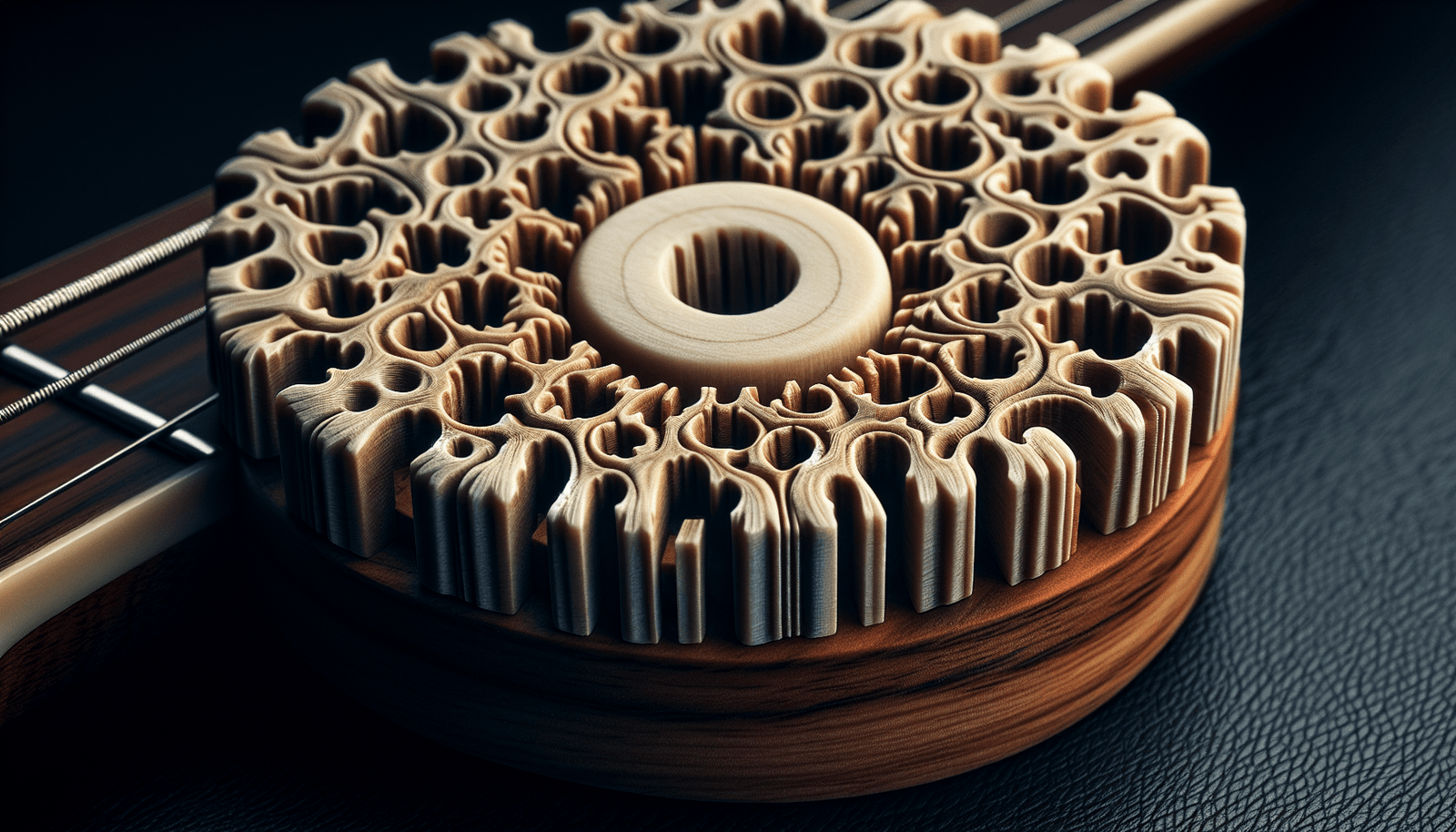If you’ve ever wondered about the impact of changing the nut on your guitar’s overall setup, you’re not alone. The nut, though seemingly small and inconspicuous, plays a crucial role in determining the tone, intonation, and playability of your instrument. From the type of material used to its height and slot spacing, any alteration to the nut can have a profound effect on how your guitar sounds and feels. In this article, we’ll explore the various ways in which changing the nut can influence your guitar’s setup, allowing you to make informed decisions when it comes to customization and optimization. So grab your guitar and let’s dive into the fascinating world of nut modifications!

What is the nut of a guitar?
Definition and purpose of the nut
The nut is a small piece usually made of bone, plastic, or metal, located at the top of the guitar’s neck, where the headstock meets the fretboard. Its primary purpose is to hold the strings in place and maintain proper string spacing and alignment. The nut also determines the string height, or action, at the first fret, which affects playability and intonation.
Materials used for nuts
Nuts are commonly made from materials such as bone, synthetic bone, plastic, brass, or even graphite. Each material offers unique characteristics, influencing the tone and playability of the guitar. Bone nuts are commonly favored by many players for their superior tonal qualities, while synthetic nuts are often preferred for their stability and consistency.
Importance of the nut in the overall setup of a guitar
The nut plays a crucial role in the overall setup of a guitar. It acts as a primary point of contact for the strings, transmitting vibrations to the rest of the instrument. The nut’s dimensions, materials, and placement impact various aspects of playability, including string height, intonation, tuning stability, and tonal characteristics. A well-fitted and properly maintained nut is essential for achieving optimal performance and sound from your guitar.
How does the nut affect the guitar’s playability?
String height and action
The nut height determines the initial string action, or how close the strings are to the frets. If the nut slots are too high, it can result in higher string action and make it more challenging to press down the strings, causing discomfort and potentially hindering playing technique. On the other hand, a nut with slots cut too low can cause buzzing or fretting out, affecting the string’s vibration and overall playability.
String spacing and alignment
The spacing of the nut slots directly affects how the strings align with the fretboard and contributes to the overall string-to-string spacing. Proper spacing ensures that the strings are evenly separated, allowing for accurate and comfortable fretting. If the string spacing at the nut is too narrow or wide, it can lead to difficulties in fretting chords or executing precise techniques.
Tuning stability
A well-cut and properly lubricated nut is essential for maintaining stable tuning. The nut slots should provide sufficient grip on the strings while allowing them to move freely during tuning. If the slots are not well-cut or the nut material is too soft or worn, the strings may bind or stick, causing tuning instability and requiring frequent adjustments.
Tonal characteristics
The nut material can significantly impact the guitar’s tone. Different materials transmit vibrations differently, affecting the sustain, resonance, and overall tonal characteristics of the instrument. While the nut’s influence on tone may not be as pronounced as other factors like the bridge or pickups, it still contributes to the overall sonic profile of the guitar.
When should you consider changing the nut?
Worn or damaged nut
If the nut shows signs of wear, such as deep grooves, notches, or cracks, it may be time for a replacement. A worn or damaged nut can lead to buzzing, intonation issues, or even string breakage. Regular inspection and maintenance can help identify such problems and prevent further damage to the guitar’s functionality.
Incorrect nut material or size
If you feel that your current nut material or size is not providing the desired tone, sustain, or playability, you may consider changing it. Experimenting with different materials, such as switching from a plastic nut to a bone nut, can yield noticeable differences in the guitar’s sound and feel. Similarly, if the current nut size does not suit your playing style or hand size, a change in nut size may be beneficial.
Desire to alter string spacing or alignment
Sometimes, players may wish to customize their guitar’s setup to better suit their preferences. Altering the string spacing or alignment at the nut can improve comfort and facilitate specific playing techniques. Changing the nut can allow for adjustments in string spacing and alignment to achieve a more personalized and ergonomic setup.
Upgrading to a higher-quality nut
If you find that your guitar’s playability or tone is limited by the stock nut, upgrading to a higher-quality nut can be a worthwhile investment. Premium materials like bone or synthetic bone are often favored for their tonal qualities and stability. Upgrading the nut can enhance the guitar’s overall sound, sustain, and playability, making it a popular choice among serious players.
Step-by-step process of changing the nut
Assessing the current nut
Start by examining the condition of the existing nut and evaluating its fit and functionality. Check for any signs of wear, damage, or poor craftsmanship. Consider measuring the string spacing and nut height to determine if any adjustments are necessary.
Choosing the right replacement nut
Research and select a replacement nut that suits your desired material, size, and characteristics. Take into account factors such as tonal preferences, playability requirements, and compatibility with your specific guitar model. Ensure that the replacement nut is of high quality and properly sized to fit your guitar’s neck.
Removing the old nut
Carefully remove the old nut using specialized tools such as nut files, saws, or chisels. Take care not to damage the guitar’s neck or surrounding areas during the removal process.
Preparing the nut slot
Clean out the nut slot thoroughly, removing any debris or adhesive residue. Ensure that the slot is clean, level, and properly aligned with the fretboard. Use files or sandpaper to make any necessary adjustments to the nut slot dimensions to accommodate the new nut.
Installing the new nut
Gently insert the new nut into the nut slot, aligning it with the fretboard and headstock. Apply a small amount of specialized adhesive, such as epoxy or super glue, to secure the nut in place. Be cautious not to use excessive glue that may interfere with the nut’s functionality or affect future removal if necessary.
Filing and shaping the nut
Use nut files or sandpaper to shape the new nut to achieve the desired string spacing and height. Take care to maintain even spacing and ensure that the strings sit properly in the nut slots. Continuously check the nut’s measurements and make adjustments as needed.
Checking string height and spacing
After filing and shaping the nut, check the string height at the first fret and ensure that it allows for comfortable and easy fretting. Verify that the string spacing is even and suits your playing style. Adjust as necessary to achieve optimal playability and intonation.

Potential issues when changing the nut
Incompatibility with the guitar’s neck
Some guitars may have unique neck profiles or dimensions that require specific types of nuts. It is important to ensure that the replacement nut is compatible with your guitar’s neck. Incompatible nuts may not fit properly or may require extensive modifications to the guitar, potentially compromising its playability and integrity.
Nut slot filing errors
Incorrectly filing the nut slots can lead to intonation problems, string buzz, or other issues. It is crucial to proceed with caution and follow a precise filing technique. Incorrect filing angles or depths can cause the strings to bind or sit too high, negatively impacting playability and tonal quality.
Intonation problems
If the nut is not properly positioned or the nut slots are inaccurately cut, it can cause intonation problems. Poor intonation results in the guitar being out of tune, even when open strings are correctly tuned. Ensure that the nut is correctly aligned and that the string slots are carefully measured and cut to maintain accurate intonation.
Adjustments required after nut replacement
Changing the nut’s material or dimensions may affect other aspects of the guitar’s setup. Adjustments to the truss rod, bridge height, or saddle position may be necessary to ensure proper string tension, intonation, and playability. It is essential to understand the potential ripple effects of nut replacement and address any necessary adjustments.
Professional vs. DIY nut replacement
Advantages of professional nut replacement
Seeking professional nut replacement services offers several advantages. Experienced guitar technicians have the expertise and specialized tools required to perform precise nut replacements. They can properly assess the guitar’s setup, recommend suitable nut materials, and execute the replacement with precision. Professional services often provide a warranty or guarantee for their work, ensuring customer satisfaction.
Cost considerations
The cost of professional nut replacement services varies depending on factors like location, technician expertise, and the complexity of the job. While professional services may require a higher upfront cost, the quality of workmanship and peace of mind they offer can outweigh the expense. DIY nut replacement may appear cost-effective initially but may result in additional costs if mistakes are made or if adjustments are required later.
Skills and tools required for DIY nut replacement
DIY nut replacement requires a certain level of knowledge, skill, and access to specialized tools. It is crucial to have the confidence and expertise to accurately assess the guitar’s setup, select suitable replacement nuts, and execute precise cutting and filing techniques. Without the necessary skills and tools, DIY nut replacement can lead to subpar results and potential damage to the guitar.
Risks and challenges of DIY nut replacement
DIY nut replacement poses various risks and challenges. Inaccurate measurements, improper cutting, or poor fitting can result in a poorly performing nut, affecting playability and intonation. Additionally, irreversible damage to the guitar’s neck or headstock can occur if not executed properly. It is important to consider one’s own skills, experience, and comfort level before attempting a DIY nut replacement.

Other factors influencing the guitar setup
Bridge and saddle
The bridge and saddle also play significant roles in the guitar’s overall setup. The bridge transfers string vibrations to the soundboard, affecting tone and sustain. The saddle, which sits atop the bridge, determines string height and intonation. Properly adjusting the bridge and saddle is essential for achieving optimal playability, intonation, and tone.
Fretwork
The condition and quality of the guitar’s frets impact playability and intonation. Fret leveling, crowning, and polishing contribute to smooth and comfortable fretting, eliminating string buzz and optimizing intonation. Proper fretwork is crucial for achieving accurate pitch and maintaining overall playability.
Truss rod adjustment
The truss rod, located within the guitar’s neck, allows for adjustments to counteract the string tension and ensure proper neck relief. Depending on factors such as climate, string gauge, and personal preference, periodic truss rod adjustments may be necessary to maintain the guitar’s optimal playability and prevent issues like fret buzzing or uneven action.
String gauge and tension
Guitar strings are available in different gauges, which affect the overall tension on the guitar’s neck. Lighter gauge strings generally exert less tension, allowing for easier bending and fretting, while heavier gauge strings provide more volume and sustain. The choice of string gauge should complement the guitar’s setup and the player’s playing style.
Environmental factors
Changes in temperature and humidity affect the guitar’s wood, leading to expansion or contraction. These variations can cause the neck to bow or warp, affecting playability and intonation. Maintaining a stable environment and using proper humidity control measures, such as a humidifier or dehumidifier, can mitigate these effects and ensure the guitar’s long-term stability.
Consultation with a guitar technician
When to seek professional advice
It is advisable to consult a guitar technician in various scenarios. If you are uncertain about the condition or functionality of the nut, or if you lack the necessary skills and tools for a DIY replacement, professional advice is recommended. Additionally, if you experience persistent issues with playability, intonation, or tuning stability after a DIY nut replacement, consulting a technician can help diagnose and address the problem effectively.
Benefits of consulting a guitar technician
Guitar technicians possess specialized expertise, experience, and tools to assess and optimize your guitar’s setup. They can accurately diagnose any issues, recommend the most suitable nut materials, and perform precise replacements. Professional services also often provide additional adjustments and setup refinements to ensure the guitar’s optimal performance.
Finding a reliable technician
When seeking a guitar technician, it is advisable to research and consider recommendations. Look for technicians with a proven track record, positive customer reviews, and experience in nut replacements. Consult with fellow musicians, local guitar shops, or online forums for reliable recommendations.
Conclusion
Summary of the nut’s impact on overall guitar setup
The nut of a guitar is a small yet crucial component that significantly affects the instrument’s playability, sound, and overall setup. Its purpose is to hold the strings in place, maintain proper string spacing, and determine string height at the first fret. The nut plays a significant role in achieving optimal action, intonation, tuning stability, and tonal characteristics.
Importance of proper nut maintenance and replacement
Proper nut maintenance, including regular inspection and lubrication, is essential for preserving the nut’s functionality and preventing unnecessary wear. When necessary, replacing the nut with a suitable material and size can enhance the guitar’s playability, tone, and overall performance. Neglecting the nut can lead to discomfort, intonation problems, and reduced playability.
Considerations for choosing professional or DIY nut replacement
While professional nut replacement offers expertise, quality assurance, and convenience, it comes at a higher cost. DIY nut replacement is a viable option for skilled and experienced individuals, provided they have the necessary tools and knowledge. However, DIY nut replacement carries risks and challenges that may result in subpar results or damage to the guitar. Consider one’s own skills, comfort level, and budget when deciding between professional or DIY nut replacement.
Properly understanding the nut’s impact on the guitar’s overall setup and consulting a reputable guitar technician when necessary will ensure optimal playability, intonation, and tone, allowing you to fully enjoy your guitar-playing experience.

Jonse Becker, a seasoned guitarist and music aficionado, founded his blog to share his passion for all things guitar. With over 20 years of experience, Jonse expertly navigates the realms of vintage acoustics and modern electrics, offering readers a rich blend of technical knowledge, history, and industry trends.

